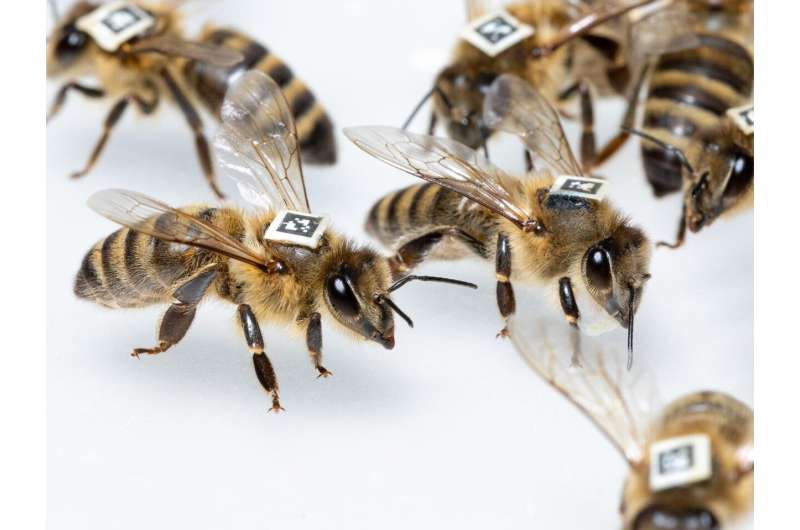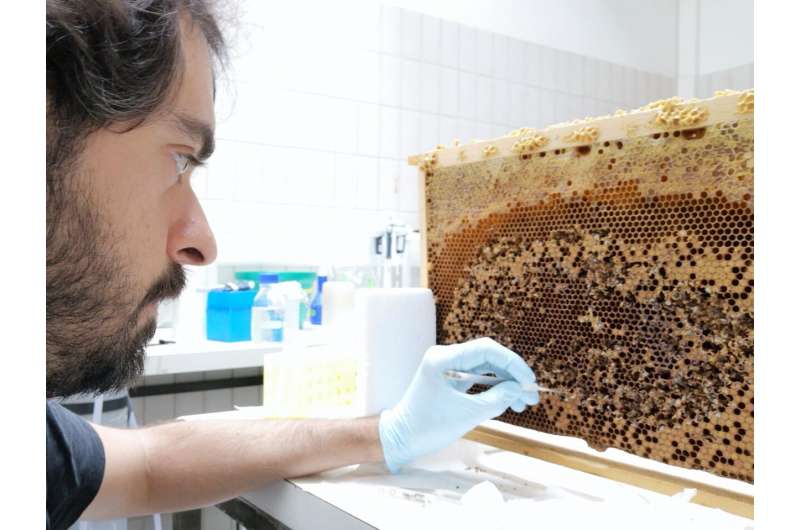Honeybees ultra-connected by their microbiome

Some insects (e.g., ants and some bees) live in intricately structured societies or colonies. Their colonies can comprise thousands of individuals specialized on different tasks. Most individuals are sterile, devoting their lives to colony tasks such as collecting food or feeding the young. More and more data suggest a link between the gut microbiota and animal social behavior. This link has previously been studied by observing interactions of pairs of individuals, but not at the societal level in a "hypersocial" animal. This knowledge-gap was filled by the discoveries made by Dr. Joanito Liberti, postdoctoral fellow in the departments of Fundamental Microbiology (DMF) and Ecology and Evolution (DEE) at UNIL, and Tomas Kay, doctoral student at the DEE, co-first authors of the article published in the journal Nature Ecology & Evolution
A simple and manageable microbiota
The honeybee is a very useful model because it harbors a simple microbiota composed of about fifteen species of bacteria. The same bacterial species are present in the guts of bees throughout the world. "A greater stability in microbiota than that of the majority of social insects," says Joanito Liberti. These microbes are all culturable in the laboratory and a team led by Philipp Engel (co-last author of the publication and associate professor at the DMF) has collections of bacterial strains ready to be tested. In addition, it is quite easy to obtain honeybees that are depleted of gut microbes without using antibiotics, which could have side effects and bias the results of the experiments. How? From a hive frame, all you must do is to carefully and patiently extract pupae (which have sterile guts) from within their sealed cells. The bees can then be colonized experimentally with known bacteria, which makes it possible to study the impact of these bacteria on the animals in a precise manner.

The result of a collaboration between scientists and bees
The postdoctoral fellow, working across two laboratories, has benefited from complimentary expertise between the bee microbiota researchers at the DMF and the knowledge on automated behavioral tracking from a team led by Laurent Keller (full professor at the DEE). "Two-hundred gut microbiota-free bees were divided into two groups, one colonized by a representative mixture of gut microbes and the other left sterile, i.e., with 100 to 1,000 times less microbes than the colonized group," says Joanito Liberti. "This experiment was performed on nine colonies."
"As we regularly do with ants, we attached a unique QR-code to each bee to allow automatic individual-level tracking," says Tomas Kay (see the IDs in the video). Monitored for over 150 hours, their interactions were recorded and "head-to-head" interactions (via their antennae or via their mouths, called proboscis) were counted (see the yellow lines representing all interaction-types in the video). The researchers found that bees with a depleted microbiota interacted less with one another than bees that had been experimentally colonized. Moreover, the latter formed more structured social networks than the former. "Each animal has best friends with whom it interacts preferentially," says Philipp Engel, enhancing the efficiency of task performance within the group.
The gut-brain axis
While the underlying mechanisms remain unknown, the biologists found some first indications. In the brains of bees colonized with gut microbiota, certain molecules (that are fundamental to brain functioning) were more abundant than in the brains of microbiota-depleted bees. For example, serine and ornithine were more abundant in the brains of microbiota-colonized bees, and in the brains of bees that interacted more frequently. In addition, the bacteria influenced the expression of certain genes in the gut and in the region of the brain responsible for the perception of olfactory (via the antennae) and taste (via the mouth) stimuli.
"These data suggest that there is a relationship between the brain functions essential to the social behavior of bees and their gut microbiota," says Joanito Liberti. An environmental emergency The gut microbiota of bees can be impaired by exposure to pesticides (e.g. neonicotinoids) or herbicides (e.g. glyphosate). The use of these toxic products could therefore disrupt the proper functioning of the brain and ultimately the natural social organization of the colonies.
"Indeed, head-to-head interactions are essential for the transmission of vital information," says Professor Engel. "General interest in the 'gut-brain' axis is growing and this avenue must continue to be explored," concludes the first author of the article.
More information: Joanito Liberti et al, The gut microbiota affects the social network of honeybees, Nature Ecology & Evolution (2022). DOI: 10.1038/s41559-022-01840-w
Journal information: Nature Ecology & Evolution
Provided by UNIL


















